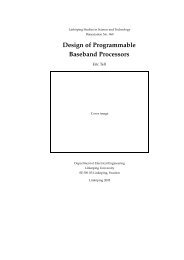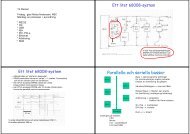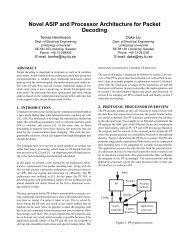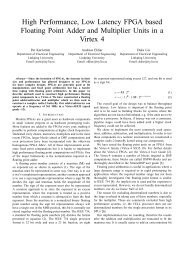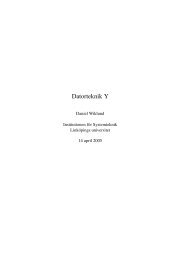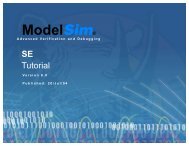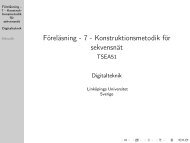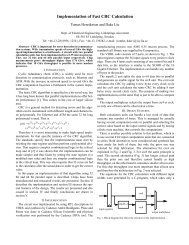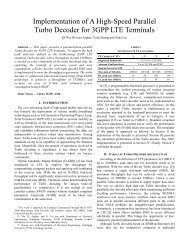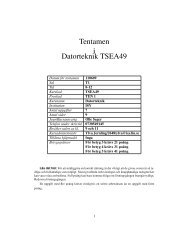Instruction and Hardware Acceleration for MP-MLQ in G.723.1
Instruction and Hardware Acceleration for MP-MLQ in G.723.1
Instruction and Hardware Acceleration for MP-MLQ in G.723.1
Create successful ePaper yourself
Turn your PDF publications into a flip-book with our unique Google optimized e-Paper software.
INSTRUCTION AND HARDWARE ACCELERATION FOR <strong>MP</strong>-<strong>MLQ</strong> IN <strong>G.723.1</strong><br />
Mikael Olausson, Dake Liu<br />
Computer Eng<strong>in</strong>eer<strong>in</strong>g<br />
Department of Electrical Eng<strong>in</strong>eer<strong>in</strong>g<br />
L<strong>in</strong>köp<strong>in</strong>gs University<br />
SE-581 83 L<strong>in</strong>köp<strong>in</strong>g, Sweden<br />
ABSTRACT<br />
This paper describes a significant improvement <strong>in</strong> complexity<br />
<strong>for</strong> the higher bit rate, 6.3 kbit/s, speech cod<strong>in</strong>g<br />
algorithm <strong>G.723.1</strong>. The solution is to reduce the number<br />
of multiplication of the most comput<strong>in</strong>g extensive<br />
part of the algorithm. This part st<strong>and</strong>s <strong>for</strong> around 50%<br />
of the total complexity. This is done by identify<strong>in</strong>g <strong>and</strong><br />
exclud<strong>in</strong>g multiplication with zeros. <strong>G.723.1</strong> is one of<br />
the proposed speech coders <strong>in</strong> the H.323 st<strong>and</strong>ard. The<br />
work has been done by thoroughly exam<strong>in</strong><strong>in</strong>g the fixed<br />
po<strong>in</strong>t source code from ITU, International Telecommunication<br />
Unions [1]. A hardware structure <strong>for</strong> an<br />
application specific <strong>in</strong>struction set processor (ASIP) is<br />
proposed to <strong>in</strong>crease the per<strong>for</strong>mance.<br />
1. INTRODUCTION<br />
The market <strong>for</strong> voice over Internet protocol, also called<br />
VoIP, has <strong>in</strong>creased over the years. Voice has been a<br />
natural choice of communicat<strong>in</strong>g <strong>for</strong> a long time <strong>and</strong><br />
will cont<strong>in</strong>ue to be so. The H.323 st<strong>and</strong>ard conta<strong>in</strong>s<br />
five different speech coders with different complexities<br />
<strong>and</strong> bit rates. The first one is G.711, which is<br />
m<strong>and</strong>atory <strong>and</strong> uses A/u-law compression at 64 kbit/s.<br />
Another coder is the G.728 Adaptive differential PCM<br />
(ADPCM) at 16 kbit/s. The third is G.722 <strong>and</strong> works<br />
on the bit rates of 48/56/64 kbit/s. The last two are<br />
more <strong>in</strong>terest<strong>in</strong>g if we are deal<strong>in</strong>g with b<strong>and</strong>width limited<br />
transmission channels. These are <strong>G.723.1</strong> <strong>and</strong> G.729.<br />
While the first one have two different bit rates specified,<br />
6.3 <strong>and</strong> 5.3 kbit/s, the last have three different,<br />
Thanks to Swedish Foundation <strong>for</strong> strategic Research (SFF)<br />
<strong>and</strong> the Technical Research <strong>and</strong> Research Education (TFF) <strong>for</strong><br />
fund<strong>in</strong>g.<br />
6.4/8.0/11.8 kbit/s. These two both have parts that are<br />
common, but also parts that differ a lot. From a market<br />
po<strong>in</strong>t of view it is of highest <strong>in</strong>terest to make the implementations<br />
of these algorithms as efficient as possible.<br />
A couple of factors may <strong>in</strong>fluence the choice<br />
of algorithm. For example some users want to squeeze<br />
as many channels as possible on a limited transmission<br />
channel. Then their choice is as low bit rate as possible<br />
if the speech quality is good enough. Others might use<br />
them <strong>in</strong> battery powered applications <strong>and</strong> their aim is<br />
low power consumption by decreased complexity with<br />
reduced speech quality as a trade off. The exam<strong>in</strong>ation<br />
is not done <strong>in</strong> deep, rather from a behavior approach<br />
where we are not bound to a certa<strong>in</strong> hardware<br />
manufacture. The quality or the robustness will not be<br />
treated.<br />
2. GENERAL DESCRIPTION OF <strong>G.723.1</strong><br />
The frame size of <strong>G.723.1</strong> is 30 ms(240 samples). In<br />
addition to this, the algorithm uses a look ahead of<br />
7.5 ms, this gives a total algorithmic delay of 37.5<br />
ms. The first component of the algorithms is a high<br />
pass filter to get rid of undesired low frequency components.<br />
The short term analysis is based on 10th order<br />
l<strong>in</strong>ear prediction (LP). These coefficients are calculated<br />
<strong>for</strong> every subframe, 7.5 ms or 60 samples. The<br />
unquantized coefficients are then transferred to L<strong>in</strong>ear<br />
Spectral Pairs (LSP) <strong>for</strong> the last subframe. These<br />
LSP are then quantized us<strong>in</strong>g a Predictive Split Vector<br />
Quantizer(PSVQ). The excitation parameters from<br />
both the fixed <strong>and</strong> the adaptive codebook are determ<strong>in</strong>ed<br />
on subframe basis. The codec then uses an open<br />
loop approach to calculate the pitch delay. It is estimated<br />
every 15 ms(every second subframe ) <strong>in</strong> the
<strong>G.723.1</strong>. This pitch value is then ref<strong>in</strong>ed <strong>in</strong> the closedloop<br />
pitch analysis. The closed-loop analysis is done<br />
<strong>for</strong> every subframe. The ga<strong>in</strong>s <strong>and</strong> the pitch delay are<br />
referred to as adaptive codebook parameters. The fixed<br />
codebook extraction is the most exhaustive part of the<br />
whole algorithm. In this codec there exist two different<br />
approaches. One, which is used <strong>in</strong> the lower bit<br />
rate 5.3 kbit/s <strong>and</strong> is called Algebraic-Code-Excited-<br />
L<strong>in</strong>ear-Prediction, (ACELP). This ACELP places at<br />
most 4 non-zero pulses with<strong>in</strong> a subframe. The positions<br />
are determ<strong>in</strong>ed from the codebook. The second<br />
approach is to use Multi-Pulse Maximum Likelihood<br />
Quantization (<strong>MP</strong>-<strong>MLQ</strong>). In this case you have more<br />
freedom to place the pulses more <strong>in</strong>dividually <strong>and</strong> not<br />
based on an algebraic codebook. It is <strong>in</strong> this part of<br />
the algorithm our proposal fits <strong>in</strong>. Any improvement<br />
<strong>in</strong> this part, will give great effects on the per<strong>for</strong>mance,<br />
because this part alone st<strong>and</strong>s <strong>for</strong> around 50% of the<br />
total execution time.<br />
3. STATISTICS OF BASIC OPERATIONS<br />
All the arithmetic <strong>and</strong> logic functions like add, sub,<br />
shift, multiply <strong>and</strong> so on are implemented with a st<strong>and</strong>ard<br />
C library. This makes it simply to do statistics<br />
over how many times different functions are used. Additional<br />
to this, the C code has been thoroughly exam<strong>in</strong>ed<br />
<strong>and</strong> all the branch, loop <strong>and</strong> move functions have<br />
also been identified <strong>and</strong> classified. All these statistics<br />
over basic operations, branch, loop <strong>and</strong> move <strong>in</strong>structions<br />
give a good h<strong>in</strong>t on where to f<strong>in</strong>d improvements<br />
on <strong>in</strong>struction <strong>and</strong> architecture level. A more detailed<br />
description can be found <strong>in</strong> [2].<br />
4. FORMER WORK<br />
In order to h<strong>and</strong>le as many channels as possible with<strong>in</strong><br />
a fixed b<strong>and</strong>width, we want an algorithm with as low<br />
output bit rate as possible. The drawback of a low<br />
bit rate is that the complexity is <strong>in</strong>creased <strong>in</strong> order to<br />
keep the quality high. In [2] there were three hardware<br />
structures proposed. They all contributed to a<br />
lower complexity. One of those proposals also hold<br />
<strong>for</strong> other speech cod<strong>in</strong>g algorithms like G.729 <strong>and</strong> also<br />
the lower bit rate of <strong>G.723.1</strong>. The first one merges<br />
the <strong>in</strong>structions 32-bit absolute value, 32-bit comparison<br />
<strong>and</strong> conditional data move of both a 32-bit data<br />
<strong>and</strong> the loop counter <strong>in</strong>to one <strong>in</strong>struction. This <strong>in</strong>struction<br />
turned out to be really useful <strong>for</strong> the speech cod<strong>in</strong>g,<br />
while they all use the analysis-by synthesis approach<br />
[3]. It is rather a trial <strong>and</strong> error procedure than<br />
a deriv<strong>in</strong>g procedure <strong>for</strong> f<strong>in</strong>d<strong>in</strong>g the best fitt<strong>in</strong>g signal<br />
out of many alternatives. In addition to this we<br />
also presented an address calculation scheme <strong>in</strong>clud<strong>in</strong>g<br />
offset address<strong>in</strong>g <strong>and</strong> absolute value calculation.<br />
These calculations were <strong>in</strong>corporated with<strong>in</strong> the address<br />
generator unit <strong>in</strong>stead of us<strong>in</strong>g the ord<strong>in</strong>ary arithmetic<br />
unit. While the first one could give complexity<br />
sav<strong>in</strong>gs from 9-15%, the last two could give sav<strong>in</strong>gs on<br />
another 5% <strong>in</strong> the higher bit rate of the <strong>G.723.1</strong> speech<br />
coder.<br />
5. HARDWARE I<strong>MP</strong>ROVEMENTS IN <strong>G.723.1</strong><br />
6.3 KBIT/S<br />
Here we will look at another part of the <strong>MP</strong>-<strong>MLQ</strong>.<br />
This part <strong>in</strong>cludes a lot of multiplications, where it<br />
turns out that many of them are just multiplication by<br />
zero. Here we can see a great potential <strong>for</strong> sav<strong>in</strong>gs.<br />
The C code <strong>for</strong> a step of the loop looks like the follow<strong>in</strong>g:<br />
<strong>for</strong>(j=0;j
£<br />
<br />
Ð<br />
м ¼<br />
½£<br />
£ ¼<br />
¾<br />
½½¿¾¼ (1)<br />
This nested loop will also be entered 64 times <strong>in</strong> the<br />
worst case <strong>and</strong> the total number of multiplications has<br />
decreased to 64*60*5.5=21120. The number of multiplications<br />
has actually decreased even more, because<br />
some of the multiplication will not occur due to the<br />
branch operation. By implement<strong>in</strong>g this <strong>in</strong> software on<br />
a DSP, the per<strong>for</strong>mance estimations can become tricky.<br />
We have <strong>in</strong>troduced a conditional branch with<strong>in</strong> the<br />
loop. While it is such a short loop, the penalty from<br />
pipel<strong>in</strong>e stalls might be high. Some DSP’s <strong>in</strong>clude operations,<br />
which can do conditional operations. A good<br />
solution here would have been a conditional multiply<strong>and</strong>-accumulate.<br />
Out of these 113280 MAC-operations are only 21120<br />
actually multiplication with oper<strong>and</strong> OccPos[j] not zero.<br />
That means that over 90000 multiplications are wasted.<br />
Be<strong>for</strong>e the loop starts all the entries to variable Occ-<br />
Pos are cleared. We only have 5 or 6 array <strong>in</strong>dices,<br />
Temp.Ploc[i] as positions, which are between 0 <strong>and</strong> 59.<br />
We also know their correspond<strong>in</strong>g values, Temp.Pamp[i]<br />
as amplitudes, which are non zero. There are six elements<br />
<strong>for</strong> even subframes <strong>and</strong> five <strong>for</strong> the odd ones out<br />
of 60 entries <strong>in</strong> OccPos, which are not zero. So, <strong>in</strong>stead<br />
of <strong>for</strong>c<strong>in</strong>g the <strong>in</strong>ner loop to multiply over all OccPos<br />
values, even the zero valued ones, we just loop<br />
over the non-zero values. The new proposed C code<br />
<strong>for</strong> this nested loop will look like the follow<strong>in</strong>g:<br />
SEGMENT<br />
ADDRESS<br />
STEP SIZE<br />
OFFSET<br />
ADDRESS REG<br />
ADDRESS<br />
<strong>for</strong>(l=59;l>=0;l–){<br />
Acc0 = (Word32) 0 ;<br />
<strong>for</strong>(j=0;j= 0 )<br />
Acc0 = L_mac( Acc0,<br />
Temp.Pamp[j], Imr[l-Temp.Ploc[j]] ) ;<br />
}<br />
Acc0 = L_shl(Acc0, 2);<br />
OccPos2[l] = extract_h(Acc0);<br />
}<br />
Fig. 1. Address generator with offset address<strong>in</strong>g <strong>and</strong><br />
segment address<strong>in</strong>g.<br />
To do this even better we will use the hardware architecture<br />
of figure 1, segmentation address<strong>in</strong>g. This<br />
one was orig<strong>in</strong>ally presented <strong>in</strong> [2]. The offset calculation<br />
is rather simple, while it is a subtraction between<br />
the loop counter <strong>and</strong> the stored value of variable<br />
Temp.Ploc[j] <strong>in</strong> a register. The offset value is then<br />
added to the start address of the variable Imr. This<br />
modification is not enough, the calculated address offset,<br />
l-Temp.Ploc[i], can po<strong>in</strong>t outside the Imr buffer<br />
<strong>and</strong> we will per<strong>for</strong>m an illegal multiplication. This can<br />
only occur when the result from the subtraction is negative.<br />
The solution is to use the msb bit from the subtraction<br />
between the loop counter <strong>and</strong> the Temp.Ploc[j]<br />
<strong>in</strong> figure 2. This data dependent control signal will<br />
then be propagated to the multiplier. If this bit turns<br />
out to be a one, i.e. a negative value of the subtraction<br />
result, the multiplier will not take the fetched oper<strong>and</strong><br />
as <strong>in</strong>put, rather it will take a zero. We call this operation<br />
conditional oper<strong>and</strong>. This will <strong>in</strong>troduce an extra
multiplexer <strong>in</strong> the multiplier circuit. The reason <strong>for</strong><br />
the extra absolute value calculation <strong>in</strong> the offset calculation<br />
circuit is found <strong>in</strong> [2]. We can address calculations,<br />
which require absolute value calculations.<br />
Control signal to the multiplier<br />
MSB<br />
LOOP COUNTER<br />
REG<br />
Cycles Operation<br />
Arithmetic operations<br />
1 16-bit operations<br />
2 32-bit operations<br />
3 32-bit absolute value calculations<br />
18 16-bit by 16-bit division<br />
20 32-bit by 16-bit division<br />
Branches<br />
1 comparison with zero<br />
2 comparison between two 16-bit values<br />
3 comparison between two 32-bit values<br />
Loops<br />
2 Loop start<br />
Moves<br />
1 16-bit move<br />
2 32-bit move<br />
OFFSET<br />
Table 1. Number of clock cycles per operation.<br />
Fig. 2. Offset calculation with loop counter <strong>and</strong> absolute<br />
value operation.<br />
6. PERFORMANCE ESTIMATIONS<br />
In order to make an estimation on the per<strong>for</strong>mance we<br />
have weighted the operation by how many clock cycles<br />
they consume. This is of course very hardware<br />
dependent, but to get a rough estimate it is a good start<strong>in</strong>g<br />
po<strong>in</strong>t. It is also important when evaluat<strong>in</strong>g the improvements.<br />
The table 1 below lists all the operations<br />
<strong>and</strong> their correspond<strong>in</strong>g clock cycle consumption.<br />
The branch <strong>in</strong>structions are weighted after the complexity<br />
<strong>in</strong> the comparison statement. If you compare<br />
with zero, then the cycle count is 1. For two 16-bit<br />
numbers the cycle count is 2 <strong>and</strong> f<strong>in</strong>ally, when you<br />
compare two 32-bit numbers the cycle count is 3. All<br />
the <strong>in</strong>itialization of loops are counted as two clock cycles.<br />
When mov<strong>in</strong>g data are 16-bit movement treated<br />
as 1 clock cycle <strong>and</strong> 32-bit movement treated as two<br />
clock cycles. The only exception is when data is set to<br />
zero, then both 16-bit <strong>and</strong> 32-bit are treated as 1 clock<br />
cycle. Table 2 gives the estimated per<strong>for</strong>mance of the<br />
four different implementations. To make the estimate<br />
even more accurate, we have also <strong>in</strong>troduced memory<br />
related issues. We have taken <strong>in</strong>to account that fetch<strong>in</strong>g<br />
oper<strong>and</strong>s from memories take one clock cycle, at<br />
least <strong>for</strong> the first oper<strong>and</strong>s of the loop. When you need<br />
the next oper<strong>and</strong> of a buffer it is assumed to be <strong>in</strong> a<br />
register already. This fetch has been done dur<strong>in</strong>g the<br />
operation of the oper<strong>and</strong>s. As we can see from table<br />
2 there is no big difference between the branch implementation<br />
<strong>and</strong> the conditional multiply. This is not<br />
true because pipel<strong>in</strong>e issues are hard to calculate. For<br />
a 2-stage pipel<strong>in</strong>e, this is true, but <strong>for</strong> deeper pipel<strong>in</strong>es<br />
you have to <strong>in</strong>sert nop operations after the branch <strong>in</strong>struction.<br />
The total complexity of the whole algorithm<br />
is around 20 MIPS, without any modifications. This<br />
value is calculated by count<strong>in</strong>g the basic operations<br />
<strong>and</strong> multiply<strong>in</strong>g them by their weights from table 1.<br />
7. CONCLUSION<br />
In this paper we have seen four different implementations<br />
of a critical part of the fixed codebook search.<br />
By exam<strong>in</strong><strong>in</strong>g the code carefully, we have reduced the<br />
number of required multiplication by more than five<br />
times. This gives a per<strong>for</strong>mance improvement of about<br />
30 % compared to the orig<strong>in</strong>al implementation. While<br />
this number just corresponds to the fixed codebook ex-
Operation Average Maximum Improve-<br />
MIPS MIPS ment<br />
Orig<strong>in</strong>al 8.40 11.08<br />
With branch 7.74 10.64 4-8 %<br />
With conditional<br />
multiply 7.41 10.12 8-11 %<br />
With extra HW 5.73 7.80 29-31 %<br />
Table 2. Per<strong>for</strong>mance estimation <strong>for</strong> the four different<br />
implementations of the fixed codebook excitation <strong>for</strong><br />
the higher bit rate of the speech coder <strong>G.723.1</strong>. The<br />
improvement <strong>in</strong> percent compared to the orig<strong>in</strong>al implementation<br />
is stated <strong>in</strong> the fourth column.<br />
citation part <strong>and</strong> this part st<strong>and</strong>s <strong>for</strong> approximately 50<br />
% of total execution time, the overall improvement is<br />
around 15 %. The modified hardware architecture to<br />
improve the per<strong>for</strong>mance is also presented. We have<br />
calculated the per<strong>for</strong>mance improvements by apply<strong>in</strong>g<br />
weights to all basic operations, add, sub, etc, branch<br />
statements, loop <strong>and</strong> move <strong>in</strong>structions.<br />
8. ACKNOWLEDGMENTS<br />
This work was f<strong>in</strong>ancially supported by the Swedish<br />
Foundation <strong>for</strong> strategic Research (SFF) <strong>and</strong> the Technical<br />
Research <strong>and</strong> Research Education (TFF).<br />
9. REFERENCES<br />
[1] ITU-T Recommendation <strong>G.723.1</strong>, Dual Rate<br />
Speech Coder <strong>for</strong> Multimedia Communications<br />
Transmitt<strong>in</strong>g at 5.3 <strong>and</strong> 6.3 kbit/s, 1996.<br />
[2] M. Olausson <strong>and</strong> D. Liu, “<strong>Instruction</strong> <strong>and</strong><br />
hardware accelerations <strong>in</strong> <strong>G.723.1</strong>(6.3/5.3) <strong>and</strong><br />
G.729,” <strong>in</strong> The 1st IEEE International Symposium<br />
on Signal Process<strong>in</strong>g <strong>and</strong> In<strong>for</strong>mation Technology,<br />
2001, pp. 34–39.<br />
[3] A.M. Kondoz, Digital Speech, John Wiley <strong>and</strong><br />
Sons Ltd, 1994.




